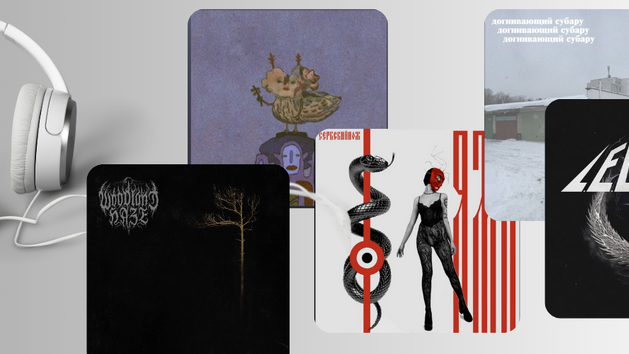In our latest review, you'll find a wide variety of music. Here you'll discover the fresh album from the world-renowned Belarusian-speaking band, an anonymous electronic compilation from Belarusian producers, the intriguing return of the band 'Mutnaevoka,' and the atmospheric duo of Hanna Zhdanava and Stas Murashka. From trip-hop to electronica, from grunge to post-punk — read our traditional review and listen to new music.
VVaxplay
Dust & Haze
The beginning of the 2010s brought many interesting bands and artists to Belarusian music, who continue to create new collectives to this day. One such example is VVaxplay. It consists of two individuals: Hanna Zhdanava, who previously sang in the indie-pop band Lilac and the satirical project "Landysh i Sakhar," and Stas Murashka — the bass guitarist of The Toobes, a member of "Valentin Strykalo" and "Soyuz," among many other lesser-known projects. On the first day of March, the duo released their debut album — Dust & Haze, featuring 11 compositions.

The roles in the duo are very precisely divided. Murashka is responsible for the instrumental part, and it's fascinating to observe how beautifully Stas the musician weaves it all together. Despite the external minimalism of Dust & Haze, there are plenty of intricate and interesting arrangements here. Describing the album stylistically is quite complex because it delves into various angles, yet it still exists somewhere between lounge, trip-hop, and jazz. It's worth noting that each composition is densely packed: if it's a guitar, it's not straightforward but delicate; if it's bass, it's dynamic and soft simultaneously; if it's electronics, it's concise and precise. On one hand, there's nothing superfluous here. On the other hand, this is achieved through very precise use of instruments.
Hanna Zhdanava shines as a vocalist and lyricist. Her simple and understandable melodies wonderfully complement the musical material, and the abstract lyrics fit well into the palette. If listening to the singer was quite challenging before, now her vocals fit seamlessly into the musical material and don't raise any questions.
VVaxplay's debut album is a wonderful presentation of the creative potential of its members. It contains many cool elements that work excellently individually and leave a very pleasant impression. What's lacking is just a bit of glue to make it a vibrant and distinctive product. Because each time you listen, you don't get the feeling that you've heard it all before — as if the songs were made from scraps of someone else's thoughts.
Mutnaevoka
«Antidepressants»
The band "Mutnaevoka" has quite an interesting history. The musicians have been playing together for quite some time, starting with grunge covers in honor of famous artists of the genre, and gradually incorporating original material. Their live performances were outstanding, thanks in part to the charisma of the band members. Eventually, they recorded a vibrant album called "Dzen' Nezalezhnastsi" (Independence Day), featuring many great songs, albeit poorly recorded. Then came the album "Metro," which had better recording quality but was uneven in content.

After a noticeable break, the band returned with a new mini-album called "Antidepressants." It's on this album that the musicians seem to have found the necessary balance. Between "Dzen' Nezalezhnastsi" and "Antidepressants," there is a significant ten-year gap. A similar gap exists between the material from these two releases. The first one was raw, audacious, and built on hooks, while the second one is mature, diverse, and very dense, almost like listening not to an EP but to a full-length album.
This comparison between the albums beautifully illustrates how the band's approach to composition has changed. "Dzen' Nezalezhnastsi" follows the standard "verse-chorus" scheme, with less attention paid to composition development. On the other hand, "Antidepressants" features fully-fledged musical pieces, quite complex and diverse. The band also experiments with styles, ranging from post-grunge to Americana, sometimes venturing into unexpected territories like black metal.
It's a very confident return to the realm of loud guitar music. Conceptually, "Mutnaevoka" remains in its place: "Antidepressants" is a dark, edgy, and audacious record, and that's what ties it with the band's previous releases.
Belarus Outside Sound System
In February, an electronic compilation titled Belarus Outside Sound System was released. It features 13 tracks by Belarusian producers and artists in various genres, ranging from slow gentle ambient to groovy aggressive techno. The main goal of the project is to explore the national cultural code through contemporary electronic flows, delve into the magical world of self-identification, and break free from this relentless rave with a precise understanding of how Belarus resonates within each participant of the process.

The task is not simple because the sound of Belarus is not always pleasant nowadays—every sound undergoes a thorough filtration in the relevant authorities. But searching for positives was also not a task: each participant of the project simply had to give their musical association on the proposed theme.
What resulted from this effort? Belarus sounds differently to different people: for some, it's the announcements in the Minsk metro, for others, it's childhood songs. It could be the fiery voice of Maria Kalesnikava, the enchanting silence of Elnya, or the whispering lullaby from the depths of consciousness. The compilation is diverse—in principle, just like our perceptions of the national cultural code. It contains compositions that you may hardly consume as an active listener, and others that are very catchy and well-structured. Maybe not everyone will listen to this collection in full and focus on specific compositions, and that's also a downside because the essence lies in offering diversity to the listener.
But here's what's important.
The Belarus Outside Sound System project raises a very poignant and relevant question about the forced anonymity of the author. Belarusian music has seen many anonymous projects, such as Zet in the past and now UNNV. But all that anonymity had a different character—it was conceptual, not forced. However, in the case of Belarus Outside Sound System, anonymity is precisely a question of the safety of the participants. Some authors hide behind pseudonyms because public exposure can be dangerous for them.
Nürnberg
Adkaz(eng. Answer
The band Nürnberg has become the most popular Belarusian-language collective globally right now. Cold and monotonous post-punk is Belarus's hallmark, an export product that is wonderfully consumed worldwide, especially in Latin America. The guys have just returned from an American tour and before that recorded a new concise album Adkaz.

An album as a promotional tool for tours is an interesting format that can work wonders. The audience listens to new songs, tastes them, and then comes to the concert already prepared and sings along with the artists. That's exactly how it looks: foreigners learn the song lyrics in Belarusian and sing along with the band.
"Adkaz" is a 26-minute compilation of eight compositions, but in reality, Nürnberg has worked with quite a tight timing: each of their albums lasts about half an hour. Another important point: there is quite a big difference between the lo-fi cassette album "Skryvaj" and the bright keyboard EP "Ahida." The first is monotonous and based on rhythmic patterns and minimalism. The second works with bright melodies and keyboard parts, so synthesizers come to the forefront.
The new album returns to schematic compositions and the dominant rhythm section. There are no bright synthesizers or catchy melodies here. On the contrary, the musicians seem to deliberately create a compilation of very intimate songs where the focus is on the mood.
First and foremost, the "Adkaz" album fulfills a marketing task, and it cannot be said that this is a new approach for the Nürnberg band. At the same time, it maintains the necessary level: the band's fans will thoroughly memorize these songs.












